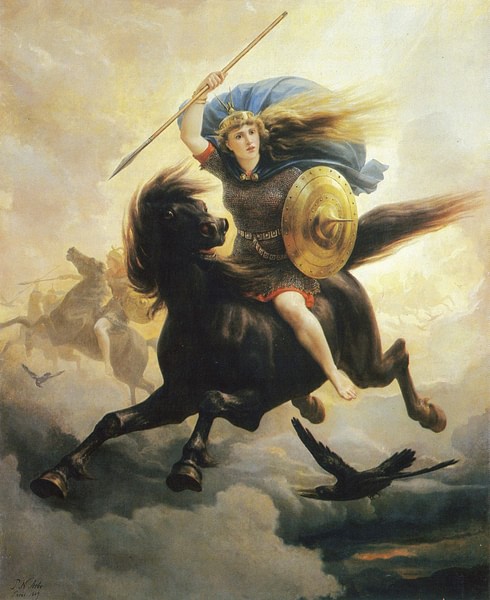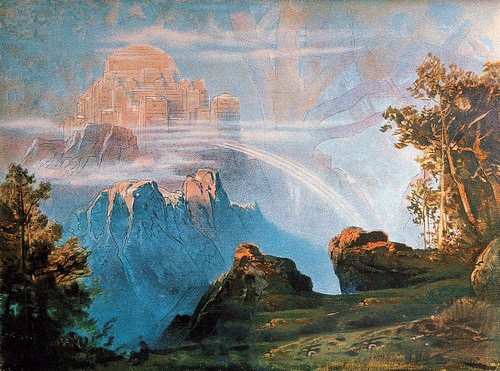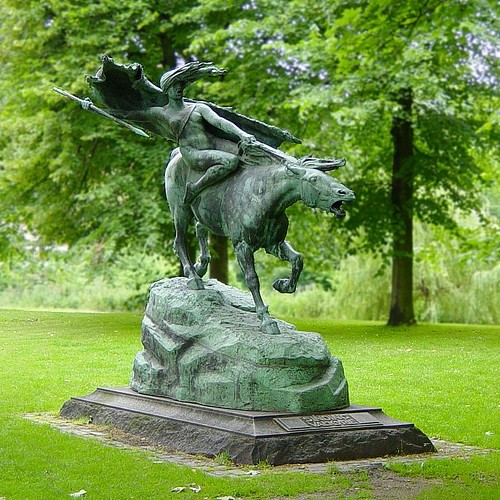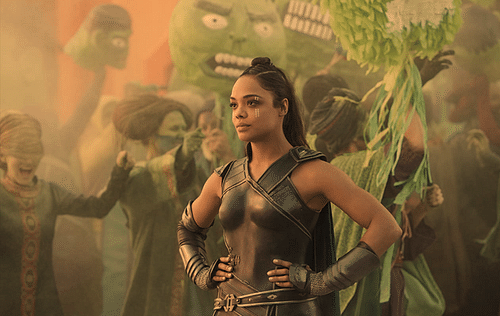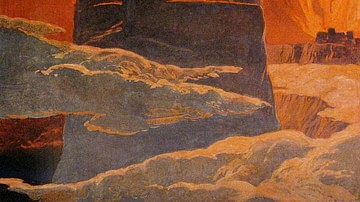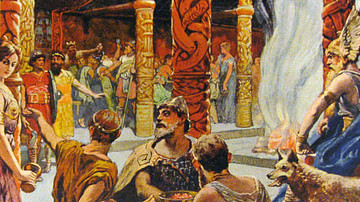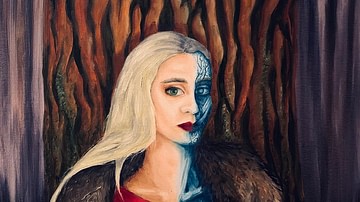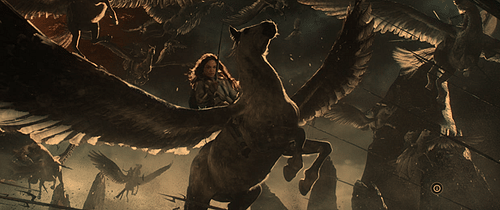
A Valkyrie is a figure in Norse mythology depicted as a warrior woman on horseback, a wolf or boar, and armed with a spear, who decides the fate of warriors in battle and carries the dead to Odin’s Valhalla. Valkyrie means "chooser of the slain", and those chosen will fight beside Odin at Ragnarök.
Valhalla is Odin’s Hall of Heroes where the spirits of fallen warriors battle each other all day, return to life and health at evening, and spend the night drinking. It was one of five possible afterlife destinations in Norse belief, the others being:
The goddess Freyja presided over Fólkvangr and chose half the dead on the battlefield for her realm; Valkyries chose the other half for Odin. The realm of Hel, presided over by the jötunn Hel, was primarily for those who died of old age or sickness (though there are notable exceptions) while the Realm of Ran was for those who drowned, especially at sea. The Burial Mound was one’s grave or tomb, which was considered the final home of the dead, no matter how they died, at different times in Scandinavian history.
Valhalla ("Hall of the Slain") may have originally been simply another name for the land of the dead and was envisioned as a vast battlefield but evolved into a Hall of Heroes who are not only led there after death by the Valkyries but are then served by them once they have become einherjar ("army of one", a hero who can handle any situation). The Valkyries, then, not only play the role of the Norns (Fates) in deciding who lives and who dies in battle but also of the psychopomp – guide in the afterlife – who provides and cares for the souls once they have arrived in Odin’s Hall, even engaging in love affairs with some of them as well as with living mortals. The Valkyries are Odin’s loyal subjects who most likely die in battle with him, Thor, the heroes of Valhalla, and many others at Ragnarök, the Twilight of the Gods.
Sources & Origin
Valkyries feature in stories from the 13th-century works Prose Edda and Poetic Edda, both collections of earlier Norse tales, as well as Germanic works. The Prose Edda was written by the Icelandic mythographer Snorri Sturluson (l. 1179-1241) and based on earlier works, while the Poetic Edda compiles verse by different authors. Norse Mythology was passed down orally for generations until c. 1000-1100 when the region was converted to Christianity, which introduced literacy. All the extant Norse myths were written by Christians or by those living in the Christian era who were at least influenced by that religion.
When the concept of the Valkyrie was first conceived of is unknown, but they may have originally been death demons (along the lines of the Greek Keres) who feasted on the bodies of the slain across battlefields and brought their souls to an underworld afterlife. The concept of Valhalla is thought to have developed relatively late and, previously, to have referred simply to an afterlife realm, possibly in the mountains or in one’s burial mound, but not the ornate hall of heroes as described in the Prose Edda, which was possibly suggested by the Christian heaven. The English Valhalla comes from the Norse Vallholl where holl may have originally meant rock, not hall, and so referred to a Rock of the Slain, meaning either a mountain or a rock-strewn battleground.
Similarly, the Valkyries are thought to have once been more menacing figures who carried souls away to a generic afterlife where anyone – warrior or not – ate and drank as they had in life. With the development of Valhalla as a Hall of Heroes, it is thought, the Valkyries were equally transformed from dark death demons to gleaming figures epitomizing both feminine beauty and masculine strength and martial skill.
It has also been suggested that the Valkyries’ image changed during the Viking Age (c. 790 - c. 1100) under influence from the shieldmaiden, a woman who took up arms and fought alongside men. The grave of one such woman has been claimed to have been discovered in 2017 near the town of Birka in Sweden (Grave Bj581), though the interpretation of the remains as those of a warrior woman has been challenged.
Scholars continue to debate whether these women existed historically, but there is no doubt they were featured in legend and myth. Among the best known from Norse tales are the goddess Freyja, the shieldmaiden Lagertha, and the heroine Hervor, along with the great Valkyrie Brynhild who challenged Odin’s will. The Valkyrie image may also have been suggested by Celtic heroines such as The Morrigan or Queen Maeve or Celtic women who dressed and fought like men. Trade relations between the Celts and Scandinavians are well established and so this is a distinct possibility as is the clear suggestion that Norse women in the Viking Age could also be warriors.
Women in Scandinavia had nearly the same rights as men, and the histories of Saxo Grammaticus (l. c. 1160 - c. 1220) report shieldmaidens fighting for the Danes (though this story has been challenged). Wives and daughters of Vikings would have had to know how to defend themselves and their lands when the men were off on their journeys. The Swedish tale of Blenda of Småland (l. c. 500 or c. 750), who leads the women of her village in killing an invading army of Danes after getting them all drunk, was popular enough to be repeated up through the 17th century, illustrating the respect accorded women as warriors; in this case, in the absence of men, but in other stories, as shieldmaidens fighting alongside males.
Afterlife Realms & the Valkyrie
The shieldmaiden was a transformative figure – a woman who dressed and fought as a man – and so would have naturally suggested itself as a model for the entities that carried the souls of heroes to a glorious afterlife. Valhalla was not the only possible destination for the dead, as noted, it was only Odin’s Hall, and there were other figures who claimed the souls of the dead for their own.
Valhalla is imagined as a great hall where the einherjar are brought by the Valkyrie, who then serve and care for them, while the Cook of the Gods, Andhrimnir, prepares them meals carved from the great beast Saerimnir (sometimes depicted as a boar) who is consumed and then regenerated daily. The magical goat Heidrun provides an endless supply of mead from its udders while the hall itself has a roof thatched with golden shields, spears for rafters, and shining coats of mail across its benches instead of hay for a cushion. The hall has 540 doors that 800 men at once can march through to battle, and the great hart Eikthyrnir’s antlers drip water into a spring that supplies clear, sweet water.
This vision of paradise is only for those who die in battle that are selected by the Valkyrie who are aligned with Odin of the Aesir – the gods of Asgard. There is another to which, it seems, other warriors go (even of the same battle) that is presided over by a member of the other leading family of the gods, the Vanir, and this is Fólkvangr, the realm of Freyja.
Freyja is another candidate as the model for the Valkyrie as she is depicted as arriving at the scene of battle and choosing heroes for her own hall, Sessrúmnir ("room of many seats") in Fólkvangr ("realm of the people") depicted as a lovely world of flowers, fields, and streams. Freyja is said to take half the dead for herself, and the Valkyrie the other half for Odin. Those who do not die in battle have different destinations awaiting them, and they are not nearly as pleasant.
Hel, presided over by Hel, daughter of Loki, is a grey, cold world below the icy realm of Niflheim surrounded by a high wall to keep the dead in and the living out. The Realm of Ran is a dark labyrinth of caves at the bottom of the sea where the goddess who drowns sailors keeps their souls. The last possible destination was one’s grave or burial mound where the soul continued to eat, drink, watch the sunset, and do anything else it did in life or, if upset for some reason or just naturally disposed to mischief, wander the surrounding area as a ghost causing trouble.
Neither Hel nor Ran seems to go out of their way to bring people to their realms, they only keep those who arrive at their door, and one’s burial mound is one’s own business. Only the realms associated with the dead who die in battle have someone to comfort and lead them from life to the afterlife, and in both cases that someone is a woman attired as a shieldmaiden, a transformational entity that empowers the soul of the deceased to leave the known world behind and embrace new possibilities.
Transformational Beings
Valkyries are consistently associated with transformation apart from their role as guide and comforter of the fallen. As they faithfully obey Odin’s wishes, they are sometimes referred to as "wish girls", but this also applied to their role in granting the wishes of mortal men they favored or who were caught by them. This "catching" took the form of a man stealing a Valkyrie’s clothes while she bathed in a brook or stream. The man would hide the clothing, and the Valkyrie would fall under a kind of spell in which she became his wife and mother of his children. If she found her clothes, she would vanish, and the man would have to undertake a quest to find her, perform one or more arduous tasks to prove himself worthy, and win her back; all of which would change him from a mere man to a hero.
The Valkyries are also associated with birds, especially ravens, which also links them with the power of second sight, divination, and flight – a form of transformation. Another version of the tale told above features a swan-maiden – the Valkyrie in swan form – whose magical feathered covering is taken by the man who then becomes her husband until the feathers are discovered by her and she leaves him. Scholar H. R. Ellis Davidson comments:
The Scandinavian Valkyrie is clearly a complex figure. Valkyries are seen in the poems as attendants on the god Odin [but] they are [also] associated to some extent with swan-maidens and may have links with the 'spirit wives' of the shamans in northern Eurasia who help and protect their human husbands and do battle with hostile spirits on their behalf as well as helping them on their journeys to the Other World. Another link is with 'shield-maids', women in the Norse sources who wear armor and fight along with men; another is with seeresses who predict the future destiny of children, and with the Norns, supernatural women who weave the fates of young heroes. (96)
The number of Valkyries is given as 9, 12, 13, or 300, but it seems they were actually without number. It has been suggested that there were 300, led by either the 9, 12, or 13, and that the Valkyries were winged women whose rank was indicated by different colored wings. The suggestion of wings is in keeping with their association with birds and also links them directly to Freyja who had a magical falcon cloak that enabled the wearer to fly.
Famous Valkyries
Considering the term Valkyrie as "chooser of the slain", the most famous of these entities would be Freyja. Freyja is depicted as choosing the dead she wants for her own realm and leaving the others to Odin’s Valkyrie. She seems almost to be a Valkyrie chief who can direct the others. In this capacity, Freyja can be seen as a kind of goddess of death or on par with the Norns who weave the fates of mortals. She may even at one point have represented battle or death in battle. She is primarily associated with love, lust, and fertility, however, and her link with those who die in battle is understood to refer to the Norse understanding of death leading to new life and renewal (as love and sex can), not the end of anything, but part of a beginning.
The names of Valkyries also suggest this as they usually have to do with the transformational act of war and the weapons used, as Davidson notes:
There are several lists of Valkyrie names, and many stress their association with battle and with the spear, which was Odin’s weapon used to determine the results of a battle. Hildr and Gunnr are poetic words for battle; Gondul (Staff-Carrier) may refer to the bearer of a spear, and Hrist may mean a spear-brandisher (from hrista, to shake). Geiravor means Spear-goddess, and Geirahod, Spear of Battle. Skogul may mean 'high-towering' and, if so, might be a reference to the gigantic size of these beings. Herfjotur (war-fetter) would presumably refer to the power of such spirits to lay invisible fetters on warriors to render them helpless in battle. These names have no individuality, but are descriptive of the nature of the war-goddesses. (96-97)
There are a number of Valkyries, however, who establish themselves as completely realized characters and autonomous individuals. Hildr, in one story, comes to the battlefield after the fighting is done for the day and walks among the slain, bringing them back to life. The warriors instantly pick up where they left off and start fighting each other, which Odin recognizes as excellent practice for the final battle at Ragnarök and so institutes this as policy. The Valkyrie Eir ("mercy") protects the living in battle instead of choosing who will die and heals the wounded afterward. Thrud ("power") is a great warrior but also a gentle caretaker of the einherjar in Valhalla (she may also be Thor’s daughter, though it is more likely the two share a name). The Valkyrie Sigrún (or Sváva) gives the hero Helgi his name and the power of speech. The Helgi poems, in fact, emphasize the transformational role of a Valkyrie more clearly than many others.
The most famous Valkyrie, however, is Brynhild (also Brunhilda, Brunhilde) of the Volsunga Saga, the epic Nibelungenlied, the Prose Edda, and the Poetic Edda who became a central character in composer Richard Wagner’s operatic cycle Der Ring des Nibelungen. After displeasing Odin by refusing to do his will, she is made mortal, placed in a deep sleep, and surrounded by a ring of fire where she will remain until rescued by a hero - and so is also famous as the inspiration for the Sleeping Beauty fairy tale.
The hero Sigurd (or Siegfried) rescues her, gives her a ring, and promises marriage, but first must travel to the court of King Gjuki. Gjuki’s wife is a sorceress who gives Sigurd a potion, making him forget Brynhild, because she wants him to marry her daughter Gudrun (also possibly a Valkyrie). Brynhild is then rescued by a man she believes to be Gunnar, Gudrun’s brother, but Gunnar was afraid to cross the ring of fire and so Sigurd shapeshifts into Gunnar to save her. She marries Gunnar but, in an argument with Gudrun, learns the truth and is enraged that Sigurd forgot her and married another. She kills him and his son and then leaps into his funeral pyre and dies. The poem Brynhild’s Ride to Hel ends with her carrying Sigurd to the afterlife and telling a giantess she encounters how she and Sigurd will now live forever in Hel’s realm as they should have on earth.
Conclusion
Brynhild’s story is only one of many Valkyrie tales, however, and they have remained among the most popular figures of Norse mythology up through the present day. Wagner’s sweeping Ride of the Valkyries (from Die Walküre, 1870) has been used in a number of films and dramatic presentations, most famously the epic 1979 film Apocalypse Now. In 1970, Marvel Comics launched the character Valkyrie (also called Brunnhilde) who rode a winged horse, Aragorn, and carried the magical spear Dragonfang. Although considered a "superhero", Brunnhilde was more or less portrayed as a traditional Valkyrie, and her stories were drawn from Norse myth.
In the 2017 film Thor: Ragnarök, the Valkyries are depicted as champions of Asgard who try to save it from the goddess Hela (a reimagined version of Hel, Queen of the Dead) and are all killed save for one. Referred to as Scrapper 142, the sole surviving Valkyrie (played by Tessa Thompson) first imprisons and then later helps Thor defeat Hela. The character again appeared in Avengers: Endgame in 2018. This vision of the Valkyrie departed from the traditional in a number of ways but remained true to the spirit of the mythological figure in courage, martial skill, and most importantly, as a transformative agent for herself and others.
